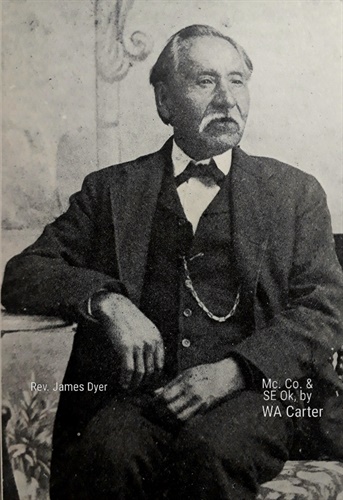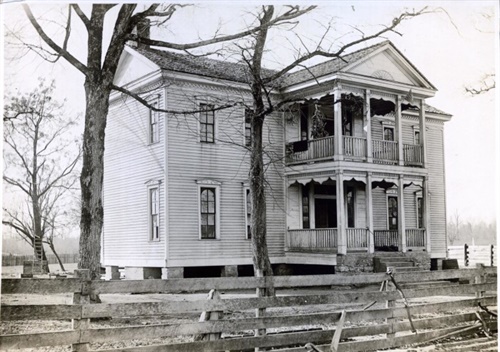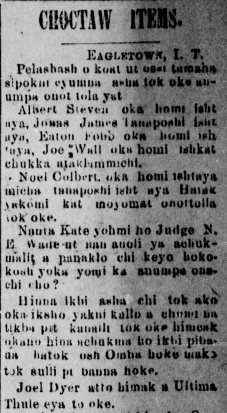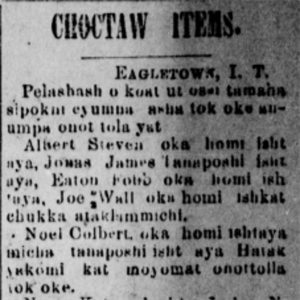De Queen, Arkansas is located approximately 16 miles due east of Eagletown, Oklahoma (formerly Eagle Town, Indian Territory). This proximity to Indian Territory had a significant influence on the news reported in the De Queen Bee newspaper. In fact, on four separate occasions the newspaper published a special Choctaw-language column printed in both Choctaw and English. The paper regularly published news from Eagletown and other towns located across the border. The Arkansas Digital Newspaper Project (ADNP) at the Arkansas State Archives (ASA) recently made historic issues of the De Queen Bee available for free on Chronicling America as part of the National Digital Newspaper Program (NDNP). These issues provided the Library of Congress’s Chronicling America website with the first (and currently only) content published in the Choctaw language. As a result of this significant paper being included in the NDNP project, I wanted to take a deeper look at the newspaper to understand the relationship between Eagletown and De Queen and learn more about the influence of the Choctaw Nation on the content published in the De Queen Bee.
Eagle Town (as it was first named) was established in 1832 by members of the Choctaw nation who were forced to relocate from Mississippi to Indian Territory (now Oklahoma). Because of its location along Military Road Trail (also known as Choctaw Trail of Tears), Eagle Town was established as the county seat of Eagle County (now McCurtain County, OK). In addition to the Choctaw, several Euro-American missionaries joined them and settled in the new land, helping establish the town. One missionary who traveled with the Choctaw people, Reverend Cyrus Byington, created the Choctaw alphabet and written language for the indigenous people. It is this newly created written language that would later be published in the De Queen Bee.
As the Kansas City, Pittsburg and Gulf (KCP&G) railroad line (running north to south along the western border of Arkansas) was established, so, too, was the town of De Queen, Arkansas. De Queen is located in southwestern Arkansas approximately six miles from the Oklahoma border. Prior to Oklahoma statehood, Indian Territory was home to many indigenous tribes, with the southeasternmost area becoming the new Choctaw Nation. Eagletown, I.T. as it was renamed in 1892, was located eight miles from the border with Arkansas.
.png?sfvrsn=4cf74be5_0)
As a result of the railroad and with an influx of Euro-American workers to the area, two investors saw an opportunity to build upon the up-and-coming timber and railroad community and founded the first newspaper in DeQueen, the De Queen Bee. The first issue of the paper was published on June 4, 1897, only a day after the town of De Queen was incorporated. Walter A. Boyd and J. W. Bishop published only 3 issues of the paper (June 4, 11, 18, 1897) before selling to E. C. Winford. It is during the early issues of the surviving newspapers, under the ownership of Winford, that we start to see the relationship between the De Queen Bee and the nearby towns in Indian Territory begin to develop. The first mention of Eagletown comes from the last page of the July 2, 1897 issue in a column titled “Eagletown, Indian Territory.” “As I have never seen any local news from our little village in your valuable paper, I thought I would let you know what we were doing over here in the Territory.” The article goes on to describe the proximity of Eagletown to De Queen and introduces some of the significant individuals and families who live in the area, including one E. E. Dyer who, I suspect, may have been the author of the column.

Photograph courtesy of the Smithville Oklahoma Historical Facebook page.
The Dyers were a prominent Choctaw family; their doings were featured prominently in the De Queen Bee’s reportage of Indian Territory and, particularly, Eagle Town. E. E. Dyer’s grandfather, Moses Dyer, was removed from Mississippi and followed the Trail of Tears to the new Choctaw Nation territory in October 1897. Moses’s son, Rev. James Dyer, father of E.E. Dyer, became a significant member of the Eagletown community and features prominently in early issues of the De Queen Bee. In the August 20, 1897 issue, the front page article “In The Territory” recounts the writer’s invitation to accompany E. E. Dyer across the border for a nearly week-long tour of the Choctaw lands. The writer, presumably E. C. Winford or newly hired A.T. Evans, visited the home of Rev. James Dyer, observed the rich rivers, lakes and farmland, and made visits to churches and schools. The article goes on to give short biographies of the Rev. James Dyer, Calvin Howell, a prominent Choctaw farmer, Ex. Governor Jeff Gardner, Sheriff Daniel Hudson and others.

Jefferson Garner's Home, photograph, May 1, 1918, Credit: Oklahoma Historical Society
Below: Screenshot of 'Choctaw Items' from 1897 De Queen Bee.

It is my opinion this trip solidified the relationship between the people of Eagletown and the publishers of the De Queen Bee. The first Choctaw language content to appear in the De Queen Bee was a front-page article on October 8, 1897. The “Choctaw Items” columns were first published in Choctaw and repeated in English. The column was much like any other small, rural town news at the time, reporting on the weather, people that are coming and going, general business dealings, court cases and community events. Similar articles appeared again in the October 15 and November 5 issues from 1897. While news of Eagletown and other Indian Territory communities continued to be reported in the paper, it wasn’t until January 6, 1911 that another column was published in Choctaw. And like with the previous columns, it covered general happenings in the town.
In addition to routine small-town news, occasionally news from Eagletown included more significant items such as in the November 5, 1897 column “Choctaw Council” in which, “A man representing a company from Oklahoma territory is here trying to buy all the timber in Red River, Eagle and Boktuklo counties.” This first-hand account of a large timber company trying to encroach on Indian Territory is historically significant. However, it isn’t the only thing that makes the relationship between the Choctaw Nation and the De Queen Bee interesting; it is the inclusion of the Choctaw language in a white, southwestern Arkansas railroad town that also tells a unique story. The successful Dyer family appears to have been the impetus for this relationship that now, more than 125 years later, gives us insight into not only life across the border in Eagletown but also how two communities on opposite sides of the border coexisted and perhaps benefited from each other.
.png?sfvrsn=1aec44e2_0&MaxWidth=400&MaxHeight=400&ScaleUp=false&Quality=High&Method=ResizeFitToAreaArguments&Signature=907AB990360CB0DFBE449E0A6D171E8B4529D449)
Google (2023) Eagletown, OK and De Queen, AR.
Read more about the De Queen Bee on Chronicling America and browse issues at https://chroniclingamerica.loc.gov/lccn/sn89051293/.
Katie Adkins is project director for the Arkansas Digital Newspaper Project, an Arkansas State Archives program established in collaboration with the National Digital Newspaper Program. Funded by the National Endowment for the Humanities and in partnership with the Library of Congress, the ASA works to digitize historic newspapers to be included on the Library of Congress’s Chronicling America website. To learn more about this historic project, visit chroniclingamerica.loc.gov. To read more about Arkansas’s involvement in the project visit https://www.arkansasheritage.com/chronicling-america-digitized-newspapers.

